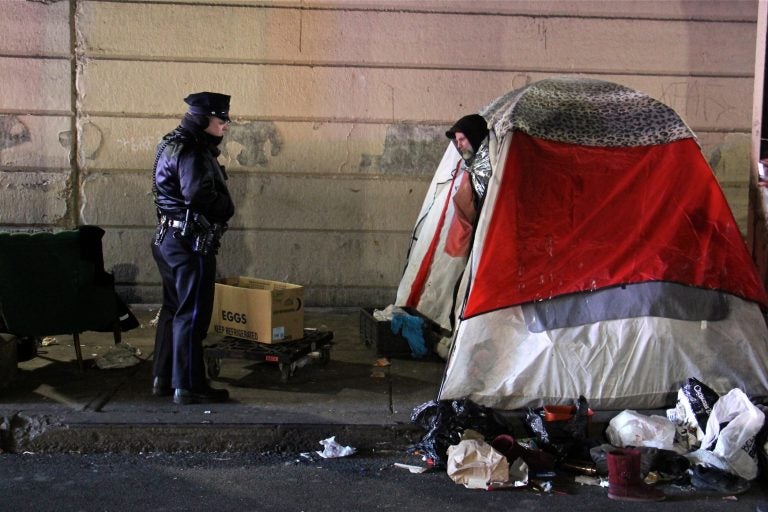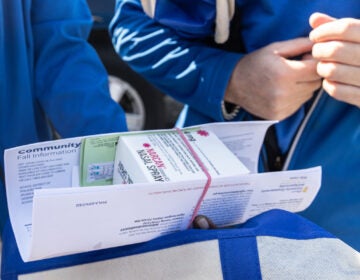With Kensington’s encampments gone, work to end opioid-related homelessness is just beginning
Philadelphia has cleared the Emerald Street encampment, but many in the grip of addiction remain on the street.

A Philadelphia police officer moves from tent to tent telling residents of the Emerald Street encampment that it's time to go. (Emma Lee/WHYY)
In bitter cold under the Emerald Street bridge, outreach workers Bridgette Tobler and Tim Sheahan hurried to help the 45 people still living there last week pack up and take the first steps toward a new life. The pair coordinated the logistics to send them to shelters and treatment programs, while handing out heavy plastic bins where the holdouts could store their belongings.
“Let’s get whatever you can so you can get up there,” Sheahan told one man sharing a tent with his cousin. “There” was one of only two shelters serving people in active addiction in the Kensington section of Philadelphia. Both shelters were full but were still taking in some of those evicted Thursday morning from the city’s last major homeless encampment.
“I’m gonna tell them to bring down one container, you’re gonna start packing, and we’re gonna get youse in, alright?” Tobler said.
Tobler and Sheahan, who work for the Department of Behavioral Health and Intellectual Disability Services, were among dozens of city workers from several agencies — along with dozens of police officers — who converged on Emerald Street to help clear the camp. The underpass buzzed with activity: workers unloading storage bins; police prodding people still in their tents; and advocates handing out doses of Narcan as reporters and camera crews hovered. But things proceeded calmly during the three hours it took to clear Kensington’s most notorious homeless encampment.
The Emerald Street evictions were the culmination of nine months of work to clear four major encampments using a new, outreach-intensive strategy for addressing opioid-related homelessness. Those camps had formed soon after the city cleaned up and secured a stretch of Conrail tracks along Gurney Street that was home to a large encampment and open-air shooting gallery. Though the tent cities that have plagued the neighborhood for nearly two years are gone now, more than 100 people who congregated there are unaccounted for, and many more are still living on the street in the grip of opioid addiction.
Officials celebrated clearing the encampments, one of the top goals of the Philadelphia Resilience Project, the city’s emergency plan for Kensington. But, they said, it’s only the beginning of the larger effort to help people in addiction and heal a neighborhood ravaged by opioids.
“The opioid crisis is not over, and the challenges it’s created have not ceased,” said Managing Director Brian Abernathy. The city will take the same outreach-centered approach should new encampments spring up, he added.
A couple dozen of the people outreach workers counted living at Emerald Street still haven’t gotten off the street. Some advocates worry that breaking up encampments could be dangerous for those who are homeless and addicted to deadly opioids, who found security in the community of the encampments.
“They’re really the first responders,” said Destinie Campanella, an advocate at Mental Health Partnerships who was helping out during the Emerald Street evictions. “If somebody experiences an overdose, they are reviving each other, they have Narcan.”
She also worried that there wouldn’t be enough resources for the city to follow through on its promises of treatment and housing.
“I’m not really sure where they’re going, if they’re going to stay there,” Campanella said.
But city officials said they had to protect the well-being of Kensington’s residents too.
Liz Hersh, director of Philadelphia’s Office of Homeless Services, said getting rid of the encampments could help stop the flow of people addicted to opioids into the neighborhood.
“Not having those camps will make it less appealing for people just to come to Kensington for a place to buy and use,” Hersh said.
While both Kensington shelters were full, officials said they had more beds available in other locations around the city for people struggling with addiction. Hersh said the city added 100 beds in other shelters during the process of clearing the four encampments, including a navigation center that opened the same day the Emerald Street campers were evicted.
Nearly half the more than 300 people outreach workers engaged with during the city’s Encampment Resolution Pilot are now off the streets, she noted, either in treatment, temporary shelters, or other housing programs. The pilot was based on a model used in San Francisco, and involved outreach workers compiling a list of everyone living at each encampment and assessing their needs during a month of intensive outreach.
Hersh said the number of people helped through the pilot was “extraordinary.”
“I just think it’s really hard to comprehend just how many needs people have … what it means to have this kind of addiction and be homeless,” she said.
Outreach workers will continue to roam the neighborhood, trying to bring more people off the street, Hersh said.
They have a new partner in the Philadelphia Police Department, which recently launched a Police-Assisted Diversion program in Kensington that allows people stopped for low-level offenses such as drug possession and prostitution to choose treatment as an alternative to prosecution.
“Our goal here is not to arrest people,” said Deputy Commissioner Joseph Sullivan, who leads the Police Department’s efforts to support the Resilience Project. “We’re dealing with people who are afflicted with an illness, and we’re going to do everything we can to get those people the treatment they need.”
For those who have gone into temporary shelters, the next challenge is connecting them to programs that can support their recovery over the long term. Hersh said the city would try to adjust the mix of resources available to them — including slots in permanent and transitional housing, recovery houses, and treatment programs — and its response to opioid-related homelessness based on their specific needs.
“There’s no road map,” she said. “What we’ve been doing over the last two years is learning from people themselves how to help them.”
She said she would meet with neighborhood groups to get feedback on how well the encampment strategy worked to improve residents’ quality of life.
More insights will come rom researchers at the University of Pennsylvania, who have been preparing an evaluation of the city’s encampment resolution pilot and will deliver a report sometime this month.
—
This article has been updated to include details about beds available in shelters outside Kensington.
WHYY is your source for fact-based, in-depth journalism and information. As a nonprofit organization, we rely on financial support from readers like you. Please give today.





